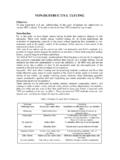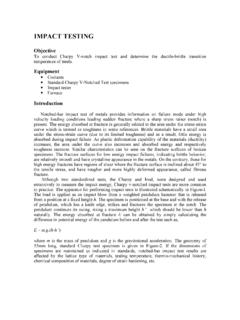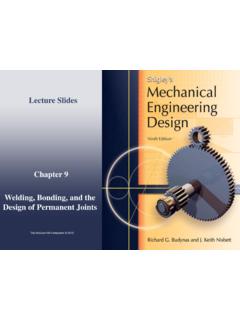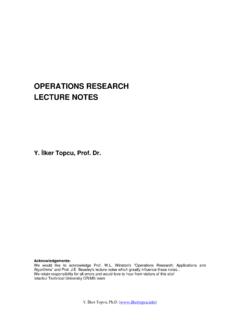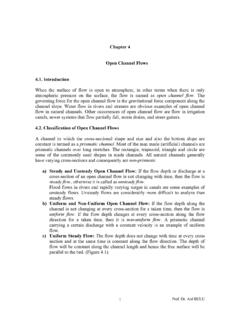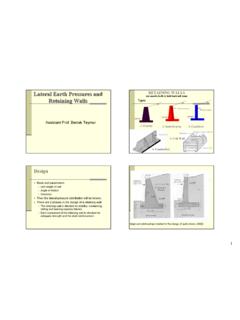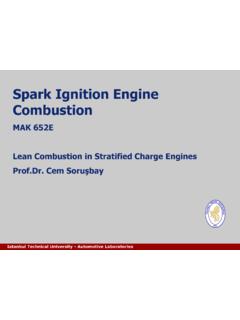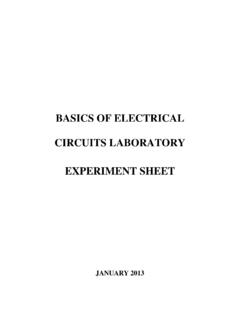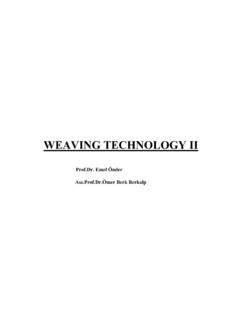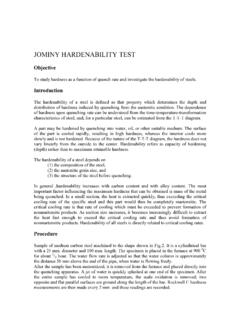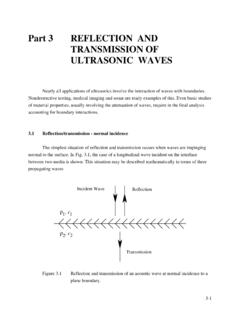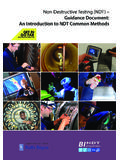Transcription of NON-DESTRUCTIVE TESTING
1 NON-DESTRUCTIVE TESTING Objective To gain experience with and understanding of the types, advantages and applications of various NDT methods. To be able to choose the best NDT method for a given part. Introduction Up to this point we have learnt various TESTING methods that somehow destruct the test specimens. These were, tensile TESTING , hardness TESTING , etc. In certain applications, the evaluation of engineering materials or structures without impairing their properties is very important, such as the quality control of the products, failure analysis or prevention of the engineered systems in service.
2 This kind of evaluations can be carried out with Non destructive test (NDT) methods. It is possible to inspect and/or measure the materials or structures without destroying their surface texture, product integrity and future usefulness. The field of NDT is a very broad, interdisciplinary field that plays a critical role in inspecting that structural component and systems perform their function in a reliable fashion. Certain standards has been also implemented to assure the reliability of the NDT tests and prevent certain errors due to either the fault in the equipment used, the miss-application of the methods or the skill and the knowledge of the inspectors.
3 Successful NDT tests allow locating and characterizing material conditions and flaws that might otherwise cause planes to crash, reactors to fail, trains to derail, pipelines to burst, and variety of less visible, but equally troubling events. However, these techniques generally require considerable operator skill and interpreting test results accurately may be difficult because the results can be subjective. These methods can be performed on metals, plastics, ceramics, composites, cermets, and coatings in order to detect cracks, internal voids, surface cavities, delamination, incomplete c defective welds and any type of flaw that could lead to premature failure.
4 Commonly used NDT test methods can be seen in table 1. These are universal NDT methods; however, very special tests have been developed for specific applications. Table 1 Commonly used NDT techniques Technique Capabilities Limitations Visual Inspection Macroscopic surface flaws Small flaws are difficult to detect, no subsurface flaws. Microscopy Small surface flaws Not applicable to larger structures; no subsurface flaws.
5 Radiography Subsurface flaws Smallest defect detectable is 2% of the thickness; radiation protection. No subsurface flaws not for porous materials Dye penetrate Surface flaws No subsurface flaws not for porous materials ultrasonic Subsurface flaws Material must be good conductor of sound. Magnetic Particle Surface / near surface and layer flaws Limited subsurface capability, only for ferromagnetic materials. Eddy Current Surface and near surface flaws Difficult to interpret in some applications; only for metals. Acoustic emission Can analyze entire structure Difficult to interpret, expensive equipments.
6 Visual inspection: VI is particularly effective detecting macroscopic flaws, such as poor welds. Many welding flaws are macroscopic: crater cracking, undercutting, slag inclusion, incomplete penetration welds, and the like. Like wise, VI is also suitable for detecting flaws in composite structures and piping of all types. Essentially, visual inspection should be performed the way that one would inspect a new car prior to delivery, etc. Bad welds or joints, missing fasteners or components, poor fits, wrong dimensions, improper surface finish, delaminations in coatings, large cracks, cavities, dents, inadequate size, wrong parts, lack of code approval stamps and similar proofs of TESTING .
7 Radiography: Radiography has an advantage over some of the other processes in that the radiography provides a permanent reference for the internal soundness of the object that is radiographed. The x-ray emitted from a source has an ability to penetrate metals as a function of the accelerating voltage in the x-ray emitting tube. If a void present in the object being radiographed, more x-rays will pass in that area and the film under the part in turn will have more exposure than in the non-void areas.
8 The sensitivity of x-rays is nominally 2% of the materials thickness. Thus for a piece of steel with a 25mm thickness, the smallest void that could be detected would be in dimension. For this reason, parts are often radiographed in different planes. A thin crack does not show up unless the x-rays ran parallel to the plane 0 the crack. Gamma radiography is identical to x-ray radiography in function. The difference is the source of the penetrating electromagnetic radiation which is a radioactive material such m Co 60.
9 However this method is less popular because of the hazards of handling radioactive materials. Liquid (Dye) penetrant method: Liquid penetrant inspection (LPI) is one of the most widely used nondestructive evaluation (NDE) methods. Its popularity can be attributed to two main factors, which are its relative ease of use and its flexibility. The technique is based on the ability of a liquid to be drawn into a "clean" surface breaking flaw by capillary action.. This method is an inexpensive and convenient technique for surface defect inspection.
10 The limitations of the liquid penetrant technique include the inability to inspect subsurface flaws and a loss of resolution on porous materials. Liquid penetrant TESTING is largely used on nonmagnetic materials for which magnetic particle inspection is not possible. Materials that are commonly inspected using LPI include the following; metals (aluminum, copper, steel, titanium, etc.), glass, many ceramic materials, rubber, plastics. Liquid penetrant inspection is used to inspect of flaws that break the surface of the sample.
